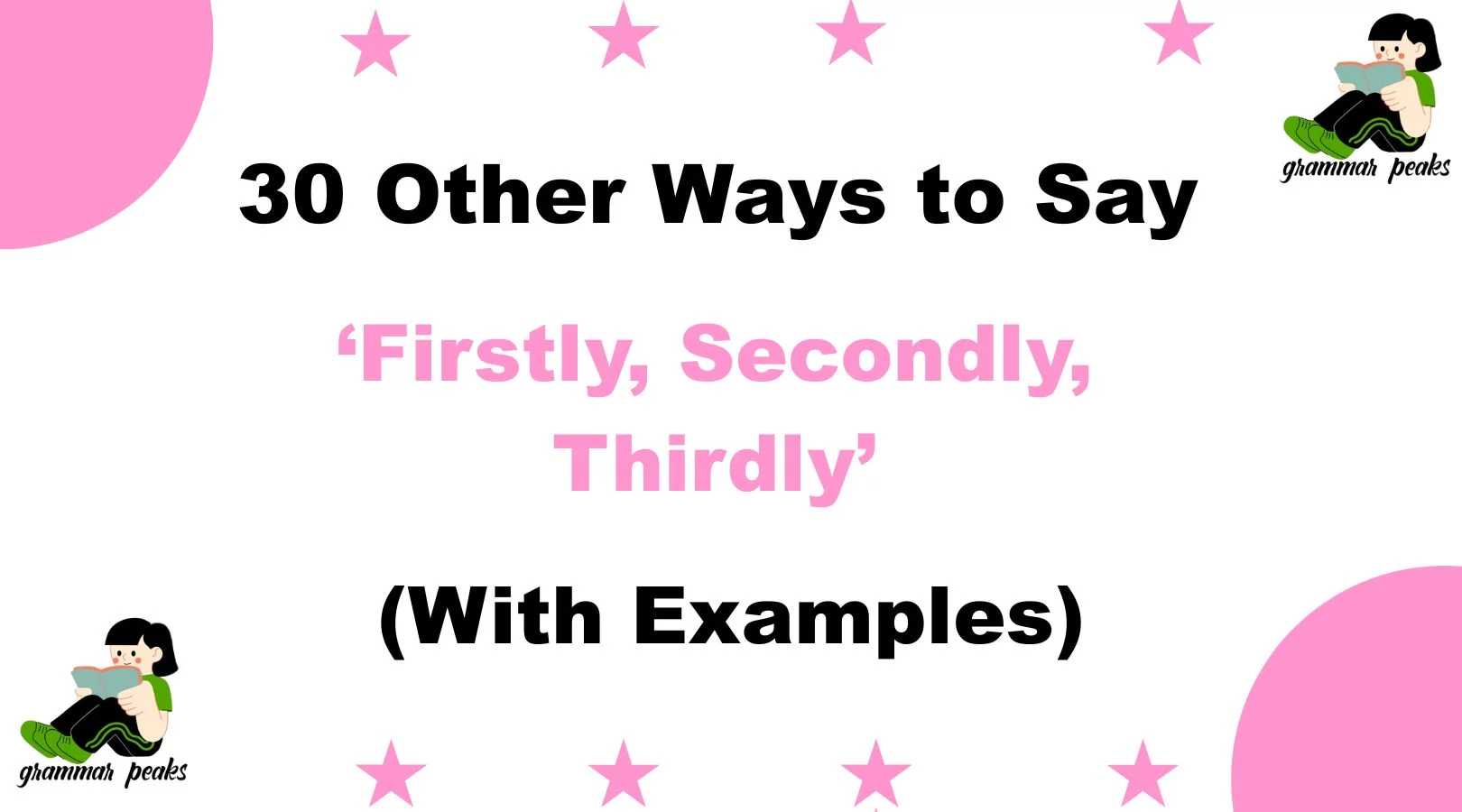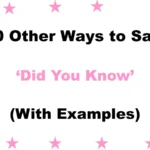Finding the right words to organise your thoughts clearly and warmly can make all the difference in communication. Using phrases like “Firstly,” “Secondly,” and “Thirdly” helps structure ideas, but sometimes, these words can feel repetitive or formal. Exploring alternative expressions allows you to convey your points in a more personal, engaging, and thoughtful way.
Whether you’re writing an email, delivering a speech, or crafting an essay, having a variety of transition phrases not only enriches your language but also helps your message resonate better with your audience. In this article, you will discover 30 creative and effective alternatives to “Firstly, Secondly, Thirdly,” complete with explanations, examples, and advice on their best use.
What Does “Firstly, Secondly, Thirdly” Mean?
“Firstly, Secondly, Thirdly” are ordinal adverbs used to introduce points or ideas in a sequence. They help organise information clearly by showing the order in which things should be considered or discussed. This makes communication easier to follow and more structured.
When to Use “Firstly, Secondly, Thirdly”
Use these phrases when you want to:
- Present multiple points in a clear, logical order.
- Emphasize the sequence of ideas or steps.
- Maintain formality and clarity in writing or speaking.
They are common in essays, presentations, reports, and discussions requiring structured arguments.
Is It Professional/Polite to Say “Firstly, Secondly, Thirdly”?
Yes! These phrases are generally professional and polite and suitable in formal and informal contexts. However, overusing them may sound repetitive or mechanical. It’s often better to vary your transitions for a more natural flow.
Pros and Cons of Using “Firstly, Secondly, Thirdly”
Pros:
- Provides clear and straightforward structure.
- Easy for the audience to follow.
- Universally understood and accepted.
Cons:
- Can become repetitive if overused.
- Might sound overly formal or stiff in casual conversations.
- Limits stylistic creativity.
Synonyms for “Firstly, Secondly, Thirdly”
- To begin with
- In the first place
- First and foremost
- As a starting point
- Primarily
- For starters
- Moving on
- Secondly
- Next
- Following that
- In addition
- Furthermore
- Thirdly
- After that
- Subsequently
- To continue
- Moreover
- Lastly
- Finally
- To conclude
- As a final point
- Ultimately
- At last
- Last but not least
- The first thing to consider
- The second point is
- The third point is
- Another point is
- Equally important
- In summary
1. To begin with
Definition: Used to introduce the first point or idea.
Detailed Explanation: This phrase signals the start of a list or argument in a friendly, conversational way.
Scenario Examples: In a presentation, “To begin with, let’s discuss our objectives.”
Best Use: Informal to semi-formal communication, speeches, or essays.
Worst Use: Overuse may reduce impact; avoid in highly formal texts.
Tone: Warm, approachable, and clear.
2. In the first place
Definition: Emphasizes the initial or primary reason or point.
Detailed Explanation: Often used to underline the most important or earliest factor.
Scenario Examples: “In the first place, safety must be our top priority.”
Best Use: When highlighting the importance of the opening point.
Worst Use: Not ideal for casual conversations due to formality.
Tone: Assertive and serious.
3. First and foremost
Definition: Highlights the most important initial point.
Detailed Explanation: This phrase stresses priority or significance.
Scenario Examples: “First and foremost, thank you all for coming.”
Best Use: Formal speeches, emails, or persuasive writing.
Worst Use: Informal chats where it may sound too strong.
Tone: Respectful and emphatic.
4. As a starting point
Definition: Introduces the beginning of a discussion or list.
Detailed Explanation: It implies that this is where the conversation or argument begins.
Scenario Examples: “As a starting point, we should analyze last quarter’s sales.”
Best Use: Business meetings or written reports.
Worst Use: Overly casual settings.
Tone: Neutral and professional.
5. Primarily
Definition: Indicates the main or most important point first.
Detailed Explanation: Used to focus on the chief element among others.
Scenario Examples: “Primarily, our goal is to increase customer satisfaction.”
Best Use: Formal documents and presentations.
Worst Use: Informal, friendly conversations.
Tone: Serious and focused.
6. For starters
Definition: Casual way to introduce the first point or idea.
Detailed Explanation: Creates a friendly tone while starting a list.
Scenario Examples: “For starters, let’s talk about our budget constraints.”
Best Use: Informal writing or speech among peers.
Worst Use: Formal professional writing.
Tone: Light and conversational.
7. Moving on
Definition: Transition phrase to introduce the next point.
Detailed Explanation: Indicates shifting focus to the next item on the list.
Scenario Examples: “Moving on, the second topic is marketing strategies.”
Best Use: Presentations or informal talks.
Worst Use: Beginning a list or point (not suitable for first point).
Tone: Smooth and conversational.
8. Secondly
Definition: Standard ordinal adverb to indicate the second point.
Detailed Explanation: Formal and clear for sequencing ideas.
Scenario Examples: “Secondly, we need to address customer feedback.”
Best Use: Formal writing and speeches.
Worst Use: Overuse may sound repetitive.
Tone: Formal and clear.
9. Next
Definition: Simple word to indicate the following item or idea.
Detailed Explanation: Less formal than “secondly,” used for smooth flow.
Scenario Examples: “Next, consider the timeline for project completion.”
Best Use: Semi-formal and informal communication.
Worst Use: Formal documents needing precise sequencing.
Tone: Neutral and friendly.
10. Following that
Definition: Indicates the point that comes immediately after the previous one.
Detailed Explanation: Creates clear sequence and connection between ideas.
Scenario Examples: “Following that, we will review our budget.”
Best Use: Reports, emails, presentations.
Worst Use: Overly casual chats.
Tone: Professional and connective.
11. In addition
Definition: Used to introduce another point that supports or adds to what was just mentioned.
Detailed Explanation: A polished and versatile phrase that transitions smoothly between ideas.
Scenario Examples: “In addition, we’ll offer free shipping this month.”
Best Use: Business writing, academic essays, or professional presentations.
Worst Use: Overly casual conversations where a simpler word like “also” fits better.
Tone: Formal, polished, and informative.
12. Furthermore
Definition: Adds another supportive point while emphasizing continuity.
Detailed Explanation: Stronger and more formal than “in addition.” It shows reinforcement.
Scenario Examples: “Furthermore, studies show that engagement improves retention.”
Best Use: Academic or persuasive writing.
Worst Use: Informal, friendly dialogue.
Tone: Serious and scholarly.
13. Thirdly
Definition: Marks the third point in a structured list.
Detailed Explanation: Like “firstly” and “secondly,” it clearly defines position.
Scenario Examples: “Thirdly, we need to evaluate our staffing needs.”
Best Use: Formal writing where structure is crucial.
Worst Use: In casual or creative writing—it may sound too stiff.
Tone: Formal and organized.
14. After that
Definition: A softer way to transition to the next idea or step.
Detailed Explanation: Maintains flow and signals progression.
Scenario Examples: “After that, we’ll move to the final discussion.”
Best Use: Presentations and storytelling.
Worst Use: Formal academic writing.
Tone: Smooth and informal.
15. Subsequently
Definition: Indicates that something happened or will happen right after another event.
Detailed Explanation: A precise term that suggests clear chronological sequence.
Scenario Examples: “Subsequently, all employees received updated guidelines.”
Best Use: Legal, academic, and process-based writing.
Worst Use: Informal chats—it can sound overly technical.
Tone: Formal and sequential.
16. To continue
Definition: Signals that you’re moving forward with the next part of a discussion.
Detailed Explanation: Keeps the flow going in a calm and deliberate way.
Scenario Examples: “To continue, let’s look at the next phase.”
Best Use: Speeches or multi-step instructions.
Worst Use: When an abrupt or dramatic transition is needed.
Tone: Neutral and smooth.
17. Moreover
Definition: Adds weight and significance to an additional point.
Detailed Explanation: Builds on previous ideas with an extra emphasis.
Scenario Examples: “Moreover, this approach reduces long-term costs.”
Best Use: Persuasive and academic writing.
Worst Use: Light, everyday conversations.
Tone: Formal and confident.
18. Lastly
Definition: Signals the final item in a list or argument.
Detailed Explanation: A common and clear way to wrap up a series of points.
Scenario Examples: “Lastly, don’t forget to submit your reports by Friday.”
Best Use: Speeches, reports, or structured discussions.
Worst Use: When the tone should be open-ended or exploratory.
Tone: Conclusive and organized.
19. Finally
Definition: Marks the end of a sequence or the ultimate point.
Detailed Explanation: Can be used to signal either relief or conclusion depending on tone.
Scenario Examples: “Finally, we can move forward with the launch.”
Best Use: Closing statements, summaries, or final instructions.
Worst Use: When more points are still to come.
Tone: Final and clear.
20. To conclude
Definition: Introduces the final summary or wrap-up of points.
Detailed Explanation: Helps neatly summarize the discussion.
Scenario Examples: “To conclude, our goals for this quarter are achievable.”
Best Use: Speeches, formal essays, and presentations.
Worst Use: At the beginning or in mid-point transitions.
Tone: Formal and summarizing.
21. As a final point
Definition: Indicates that this will be the last idea discussed.
Detailed Explanation: Gives a polite signal that the message is wrapping up.
Scenario Examples: “As a final point, let’s thank the team for their hard work.”
Best Use: Presentations or formal discussions.
Worst Use: Casual settings where simpler phrasing is more appropriate.
Tone: Professional and respectful.
22. Ultimately
Definition: Indicates the final result or overarching conclusion.
Detailed Explanation: Often used to draw attention to a big-picture idea.
Scenario Examples: “Ultimately, our goal is to improve customer loyalty.”
Best Use: Strategic conversations or reflective writing.
Worst Use: Everyday lists of steps or casual conversation.
Tone: Insightful and reflective.
23. At last
Definition: Suggests the end of a long process or journey.
Detailed Explanation: Adds emotion or relief to the final point.
Scenario Examples: “At last, we’re seeing progress in the project timeline.”
Best Use: Storytelling or dramatic speeches.
Worst Use: Academic or technical writing.
Tone: Emotional and expressive.
24. Last but not least
Definition: Highlights the importance of the final point.
Detailed Explanation: Shows that the final item is no less significant.
Scenario Examples: “Last but not least, let’s thank our volunteers.”
Best Use: Speeches and acknowledgments.
Worst Use: Very formal documents.
Tone: Friendly and appreciative.
25. The first thing to consider
Definition: An introductory phrase for structured reasoning.
Detailed Explanation: Makes the order of importance clear.
Scenario Examples: “The first thing to consider is your target audience.”
Best Use: Planning meetings, reports, or analytical writing.
Worst Use: When brevity is more effective.
Tone: Thoughtful and analytical.
26. The second point is
Definition: Directly introduces the second item or idea.
Detailed Explanation: Keeps writing organized and easy to follow.
Scenario Examples: “The second point is our improved delivery timeline.”
Best Use: Business proposals or formal presentations.
Worst Use: Informal speech or when more fluid language is needed.
Tone: Direct and logical.
27. The third point is
Definition: Continues structured discussion by introducing a third idea.
Detailed Explanation: Maintains clarity and coherence.
Scenario Examples: “The third point is related to staff training.”
Best Use: Formal documents and strategic presentations.
Worst Use: Personal or informal communication.
Tone: Professional and structured.
28. Another point is
Definition: Introduces an additional thought without a strict order.
Detailed Explanation: Offers flexibility while still being clear.
Scenario Examples: “Another point is how we manage our schedule.”
Best Use: Brainstorming, casual reports, or essays.
Worst Use: Legal or sequential documentation.
Tone: Neutral and flexible.
29. Equally important
Definition: Emphasizes that this point is just as significant as previous ones.
Detailed Explanation: Useful when all ideas should be weighed similarly.
Scenario Examples: “Equally important is maintaining customer trust.”
Best Use: Balanced arguments or persuasive content.
Worst Use: Basic instructions or chronological sequences.
Tone: Emphatic and balanced.
30. In summary
Definition: Signals a wrap-up or concise review of all previous points.
Detailed Explanation: Prepares the reader or listener for a conclusion.
Scenario Examples: “In summary, these strategies will help grow the business.”
Best Use: Conclusions in essays, reports, or public speaking.
Worst Use: When more content is yet to follow.
Tone: Concise and reflective.
Conclusion
Using a variety of alternatives to “Firstly, Secondly, Thirdly” adds depth, warmth, and clarity to your communication. These phrases help tailor your message to the tone, audience, and context—whether you’re writing a heartfelt note, giving a formal presentation, or making a structured argument. The key is to choose expressions that not only organize your thoughts but also connect emotionally with your audience. Thoughtful language leads to meaningful conversations—and that’s always worth the extra effort.
FAQs
1. Why should I use alternatives to “Firstly, Secondly, Thirdly”?
Using a variety of alternatives helps your communication feel more natural, engaging, and less repetitive. It allows you to adapt your tone for different contexts—whether it’s a formal report, a casual blog post, or a heartfelt message. It also improves readability and audience connection by matching the flow of your content to the situation.
2. Are these alternatives acceptable in professional writing?
Yes, many of the listed alternatives—such as “In addition,” “Moreover,” and “To conclude”—are highly appropriate for business, academic, and professional contexts. Choosing more varied phrasing can actually enhance clarity and demonstrate strong writing skills, as long as the tone matches your audience.
3. Can I mix formal and informal alternatives in the same piece?
It’s best to maintain a consistent tone throughout your writing. If your piece is professional, stick with formal alternatives like “Firstly,” “Subsequently,” or “Moreover.” In casual settings like blogs or speeches, feel free to use “For starters” or “Moving on.” Mixing both can confuse the reader or break the flow.
4. Do these alternatives work for speaking, or are they just for writing?
These alternatives work for both spoken and written communication. Phrases like “First and foremost” and “To begin with” are commonly used in presentations, speeches, and conversations, helping you sound polished and organized.
5. How can I decide which transition phrase to use?
Start by considering the tone, purpose, and audience of your message.
- Use formal phrases (like “Subsequently” or “To conclude”) for professional or academic settings.
- Use conversational phrases (like “Next up” or “Another point is”) for personal blogs or casual talks.
Also, think about whether you’re emphasising order, importance, or continuation—each alternative subtly shifts the meaning and mood of your message.






